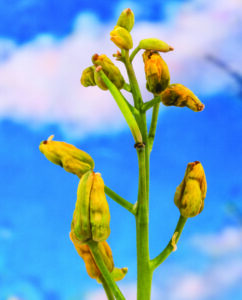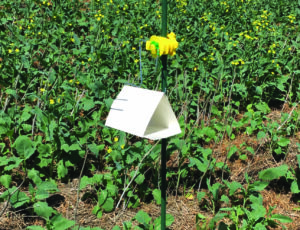Trap to monitor canola flower midge
KEY RESULT:
This project developed a reliable, pheromone-trapping system to monitor Contarinia brassicola, canola
flower midge.
PROJECT NAME, PRINCIPAL INVESTIGATOR:
“Monitoring the canola flower midge within pheromone-baited traps,” Boyd Mori and Kyle Van Camp, University of Alberta
FUNDING:
SaskCanola, Alberta Canola, Manitoba Canola Growers, Western Grains Research Foundation
PUBLISHED ARTICLES:
Read the full report on the Canola Research Hub.

Photo credit: Shelley Barkley
Canola flower midge, Contarinia brassicola, is a newly discovered insect pest of canola with relatively unknown pest potential. Larvae feed on developing flower buds, which prevents the flowers from opening and forming pods. Though widespread across the Prairies, canola flower midge population density is variable across the species range and damage is discreet and can be easily overlooked, except under outbreak conditions.
Previous work identified the female-produced canola flower midge pheromone and optimized the pheromone blend and dose to create a potent male attractant. This project refined the pheromone trapping system and evaluated the relationship between adult midges captured in pheromone-baited traps and damage in the field. It also explored weather conditions that might influence populations, midges’ ability to infest canola at different growth stages, and alternative hosts.
Researchers carried out field studies in commercial canola production fields in central Alberta in 2021 and 2022. Experiments took place over the growing season. Of note, 2021 was an extreme drought and many fields had poor yields.
In the lab, researchers monitored midge to determine if males and females emerge in equal numbers and their lifespan.
Results

Researchers identified the pheromone-baited Jackson trap, deployed 50 cm above the soil surface along the crop edge, as the optimal combination of trap type and position to effectively monitor the canola flower midge. Male midge activity peaked twice during the day – morning and late-afternoon – which could be used to increase the precision of monitoring strategies or potential treatment applications.
Over the two years of this study, the number of male midges captured on pheromone-baited traps was not predictive of damage in the field. Average air temperature and weekly cumulative rainfall, at the scale measured in this study, did not have an impact on the number of midges captured in either year.
Midge larvae were identified from pods in commercial canola fields and experiments also confirmed canola flower midge larvae can develop in pods, but no alternative host plants were identified.
Although individual midge are short-lived, the midge emergence is prolonged over the summer when canola plants are susceptible to infestations. Researchers urge continued monitoring and vigilance for this species as its full pest potential is yet to be determined.





